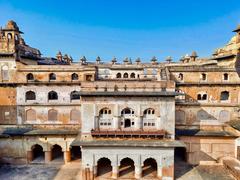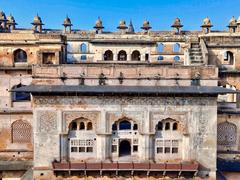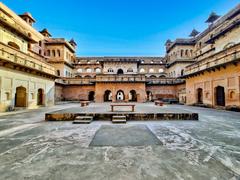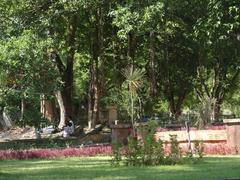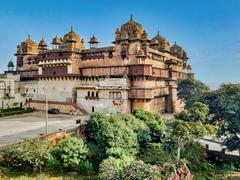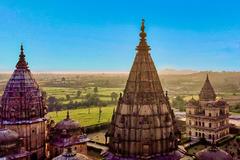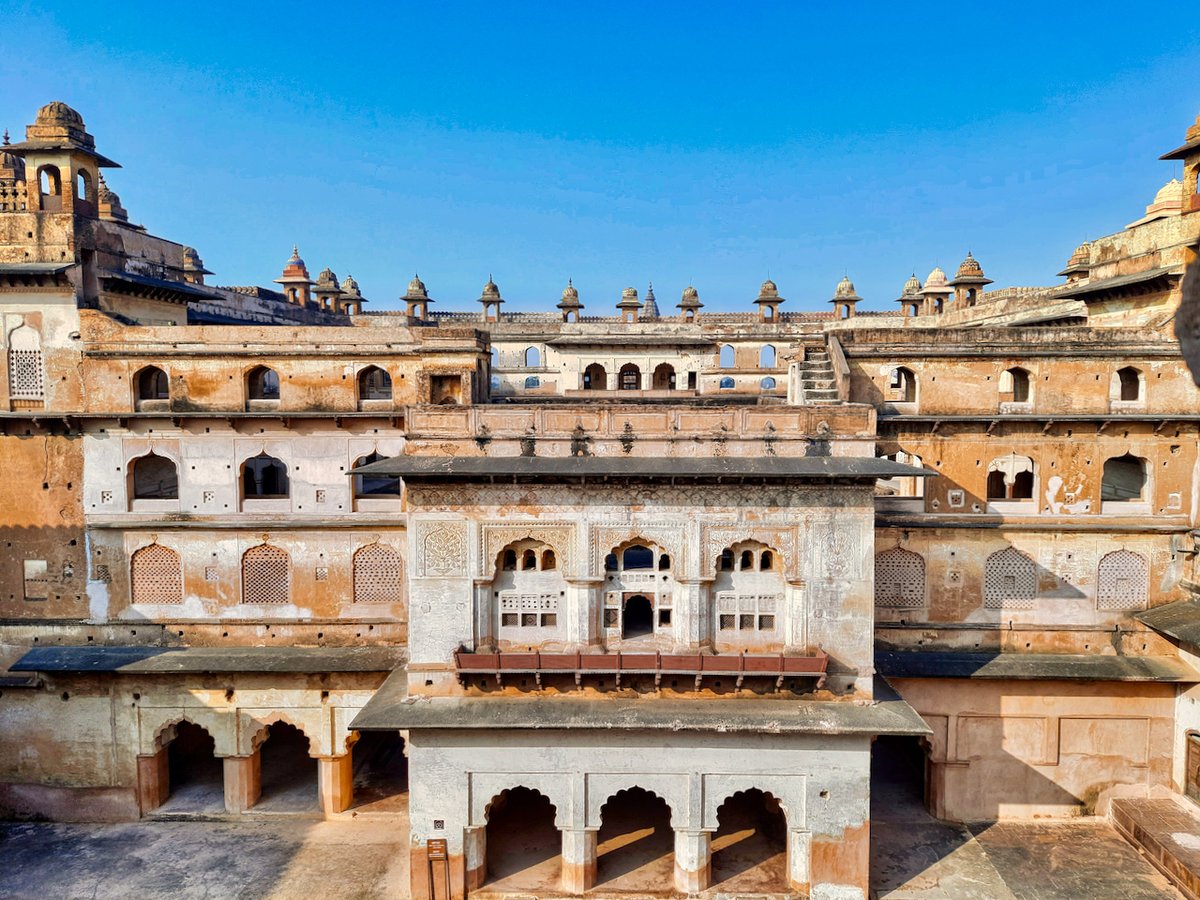
Raja Mahal Orchha: Visiting Hours, Tickets, and Complete Travel Guide
Date: 14/06/2025
Introduction
Raja Mahal, nestled within the Orchha Fort complex in Madhya Pradesh, India, stands as a magnificent monument reflecting the Bundela Rajput dynasty’s architectural ingenuity, cultural prosperity, and spiritual devotion. Built in the 16th century by Raja Madhukar Shah, this palace not only served as the royal residence but also as a hub for political, artistic, and religious life in Orchha. Its unique blend of Rajput fortifications and Mughal aesthetics, adorned with intricate frescoes depicting Hindu mythology, makes Raja Mahal a standout among Orchha historical sites (TravelTriangle; TempleYatri). This guide provides comprehensive information on Raja Mahal visiting hours, ticket prices, accessibility, travel tips, and nearby attractions, ensuring you make the most of your visit to this iconic destination.
Table of Contents
- Historical Background
- Visitor Information
- Visuals and Media
- Frequently Asked Questions (FAQ)
- Conclusion
- References
Historical Background
Origins and Construction
Commissioned by Raja Madhukar Shah in the 1570s, Raja Mahal stands as the principal royal residence of Orchha’s Bundela dynasty (TravelTriangle; The Floating Pebbles). Orchha’s strategic location by the Betwa River offered natural defense, making it an ideal site for a thriving kingdom.
Architectural Style and Layout
Raja Mahal is an exemplar of the Bundeli style, seamlessly fusing Rajput and Mughal architectural elements. Its five-storied structure features robust exteriors with ornate interiors, grand courtyards, audience halls, private chambers, and balconies overlooking the river (The Floating Pebbles). Notable elements include the Darbar-i-Khas (private audience hall), Baradari pavilion, Zenana courtyard for the women’s quarters, and panoramic rooftop vistas.
Artistic Flourishes: Murals and Decorative Elements
The palace interiors are adorned with vivid 16th-century frescoes using natural pigments. These murals depict scenes from the Ramayana, Mahabharata, and the Dasavatara of Vishnu, alongside floral and geometric motifs that symbolize prosperity and divine order (The Floating Pebbles; TempleYatri). The narrative sequence and use of color reflect the sophistication and religious devotion of the Bundela court.
Political and Cultural Significance
Raja Mahal was more than a royal abode; it was the political and cultural heart of Bundela Orchha, witnessing key alliances and negotiations with the Mughal Empire. The palace played a pivotal role in shaping Orchha’s unique artistic legacy and spiritual landscape (TravelTriangle).
Evolution and Preservation
Though Orchha ceased as the capital in 1783, Raja Mahal endures as a symbol of Bundela heritage. Conservation efforts by the Archaeological Survey of India focus on preserving its murals and structural integrity (TravelTriangle). The fort complex is a contender for UNESCO World Heritage status, reflecting its global cultural value.
Raja Mahal in the Orchha Fort Complex
Raja Mahal is accompanied by other major structures within the Orchha Fort, such as Jahangir Mahal, Sheesh Mahal, and Rai Parveen Mahal. While Jahangir Mahal showcases Mughal grandeur, Raja Mahal is the oldest and historically most significant palace within the complex (The Floating Pebbles).
Legends and Anecdotes
Local legends, such as the tale of Raja Madhukar Shah’s devotion to Lord Rama and the origins of the Ram Raja Temple, infuse Raja Mahal with a spiritual aura (The Floating Pebbles).
Visitor Information
Visiting Hours
- Daily: 8:00 AM to 5:00 PM
(Some sources may list 9:00 AM as opening; verify before your visit for any seasonal adjustments.)
Ticket Prices
- Indian Nationals: INR 10–25 (varies by source)
- Foreign Nationals: INR 250–300
- Children under 15: Free
- Camera Fee: INR 400 for photography inside the palace
Tickets are valid for all monuments within the Orchha Fort complex for one day. Purchase at the entrance or online via official portals (Two Flashpackers; TravelSetu).
Accessibility
Due to its historic architecture, Raja Mahal is only partially accessible for visitors with mobility challenges. The main courtyards and ground floor are generally accessible, but upper floors require climbing steep stairways (Holiday Landmark).
Guided Tours and Audio Guides
- Local guides are available at the entrance and through hotels/tour operators.
- Guided tours offer historical context, stories, and explain the significance of murals and architecture.
- Audio guides may be available to rent or download.
Travel Tips
- Footwear: Wear comfortable shoes for uneven terrain.
- Hydration: Carry water, especially in warmer months.
- Photography: Permitted with a valid camera ticket; avoid flash near frescoes.
- Safety: Supervise children on upper floors and balconies.
- Facilities: Restrooms are near the entrance; snacks and souvenirs are sold outside the fort.
- Best Season: October–March for pleasant weather and lively festivals (MakeMyTrip).
Nearby Attractions
- Jahangir Mahal: Noted for Mughal design and historical significance.
- Chaturbhuj Temple: Famous for its height and unique temple-fort architecture.
- Laxminarayan Temple: Known for vibrant murals.
- Chhatris (Cenotaphs): Memorials along the Betwa River.
- Ram Raja Temple: Unique for worshipping Lord Rama as a king.
Visuals and Media
Explore our curated photo gallery and virtual tours on the website to preview Raja Mahal’s frescoes, architecture, and panoramic views. All visuals are equipped with descriptive alt text for accessibility, such as “Raja Mahal murals Orchha” and “Orchha historical sites rooftop view.”
Frequently Asked Questions (FAQ)
Q: What are the Raja Mahal visiting hours?
A: Open daily from 8:00 AM to 5:00 PM. Confirm ahead for possible changes.
Q: How much are Raja Mahal tickets?
A: INR 10–25 for Indian nationals, INR 250–300 for foreigners. Children under 15 enter free. Camera fee: INR 400.
Q: Are guided tours available?
A: Yes, local guides can be hired at the entrance or booked through hotels/tour agencies.
Q: Is Raja Mahal wheelchair accessible?
A: The ground floor and courtyards are accessible, but upper levels are not due to steep stairs and uneven floors.
Q: What’s the best time to visit Raja Mahal and Orchha?
A: October to March for pleasant weather and festivals such as Dussehra and Holi.
Conclusion
Raja Mahal is the crown jewel of Orchha historical sites, offering a harmonious blend of Rajput strength, Mughal elegance, and Bundela artistic legacy. Its vivid frescoes, panoramic views, and rich history make it a must-visit for history buffs, art lovers, and cultural explorers. To get the most out of your visit, check Raja Mahal’s visiting hours and ticket prices in advance, consider a guided tour, and explore nearby monuments within the Orchha Fort complex. Download the Audiala app and stay updated on travel tips, festival schedules, and new virtual experiences as you embark on your journey through Orchha’s living heritage.
Internal Links
References
- Raja Mahal Orchha: Visiting Hours, Tickets & Historical Guide to Orchha’s Iconic Palace, 2024, TravelTriangle
- Raja Mahal Orchha: Visiting Hours, Tickets, and Architectural Marvels of Orchha Historical Site, 2024, TempleYatri
- Raja Mahal in Orchha: Visiting Hours, Tickets & Cultural Significance, 2024, Culture and Heritage
- Raja Mahal Visiting Hours, Tickets, and Complete Guide to Orchha Historical Sites, 2024, TravelSetu
- Raja Mahal Visiting Hours, Tickets, and Complete Guide to Orchha Historical Sites, 2024, Two Flashpackers
- Raja Mahal Orchha: Visiting Hours, Tickets & Historical Guide to Orchha’s Iconic Palace, 2024, The Floating Pebbles
- Raja Mahal in Orchha: Visiting Hours, Tickets & Cultural Significance, 2024, Academia Indica
- Raja Mahal in Orchha: Visiting Hours, Tickets & Cultural Significance, 2024, Tale of 2 Backpackers
- Holiday Landmark
- MakeMyTrip
- Vacation India
- Panna National Park
- EdTerra
